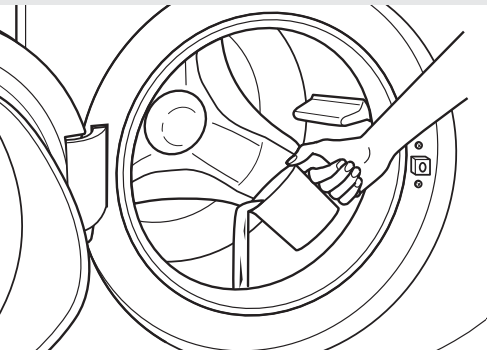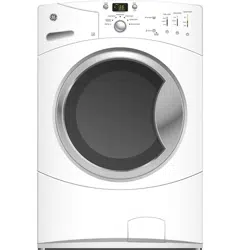Documents: Go to download!
User Manual
- User Manual - (English, French, Spanish)
- Quick specs - (English)
- Energy Guide - (English)
User Manual of Frontload Washer
CONTROL PANELS
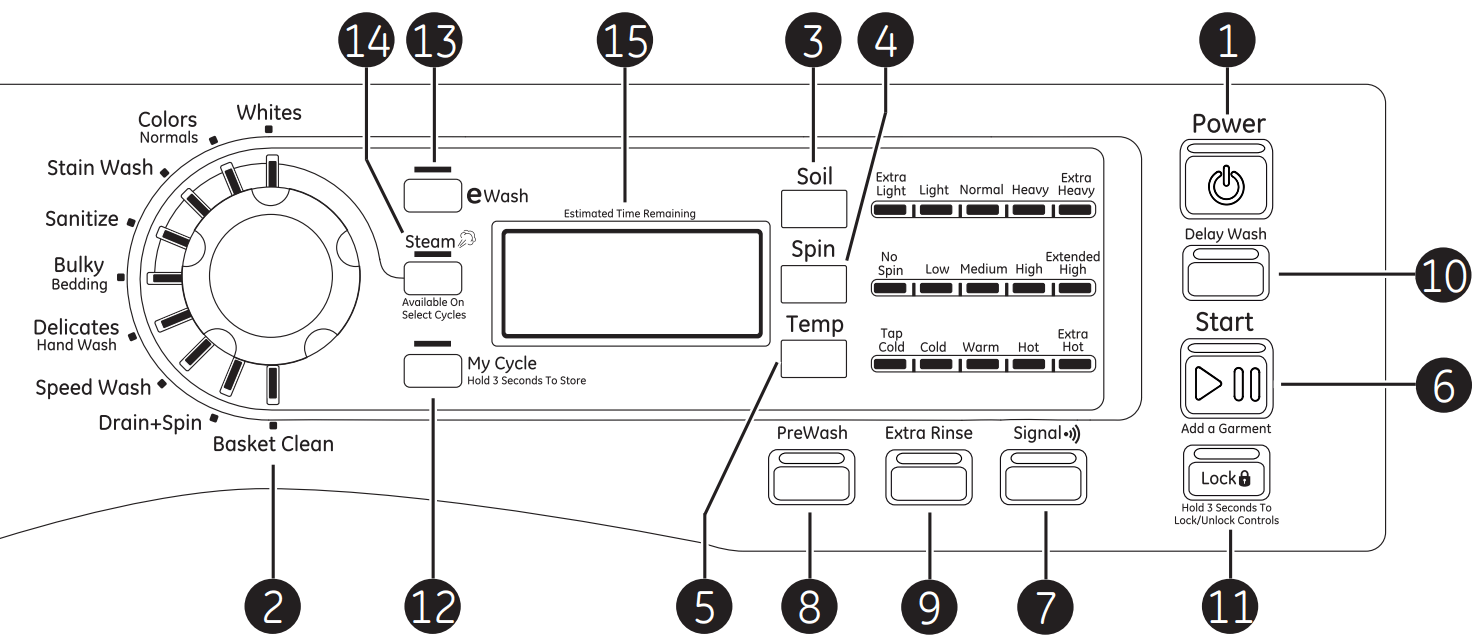
1. Power
Press to “wake up” the display. If the display is active, press to put the washer into standby mode.
NOTE: Pressing Power does not disconnect the appliance from the power supply.
2. Wash Cycles
The wash cycles are optimized for specific types of wash loads. The chart below will help you match the wash setting with the loads. The GentleClean™ lifters lightly tumble the clothes into the water and detergent solution to clean the load.
| Whites | For heavily to lightly soiled white laundry. |
| Colors/Normals | For heavily to lightly soiled colorfast cottons, household linens, work and play clothes. |
| Stain Wash | For heavily soiled colorfast laundry. |
| Sanitize | When selecting sanitize, the washer increases the water temperature to sanitize on some models) and remove 99.9% of bacteria found in home laundry. For best results, select the heavy soil setting when using the sanitize cycle. |
 | |
| Bulky Bedding (on some models) | For large coats, bed spreads, mattress covers, sleeping bags and similar large and bulky items. Large items such as blankets, comforters, jackets and small rugs. |
| Delicates | For lingerie and special-care fabrics with light to normal soil. Provides gentle tumbling and soak during wash and rinse. |
| Speed Wash | For lightly soiled items that are needed in a hurry. Cycle time is approximately minutes, depending on selected options. |
| Drain & Spin | Drain and spin at any time. |
| Basket Clean | Use for cleaning the basket of residue and odor. Recommended use of once per month. |
NOTE: Never load laundry while using Basket Clean. The laundry may become damaged or contaminated. See the Care and Cleaning section.
3. Soil Level
Changing the Soil level increases or decreases the wash time to remove different amounts of soil.
To change the Soil level, press the Soil level pad until you have reached the desired setting.
4. Spin Speed
Changing the Spin speed changes the final spin speed of the cycles. Always follow the fabric manufacturer’s care label when changing the spin speed.
To change the spin speed, press the Spin speed pad until you have reached the desired setting. Higher spin speeds are not available on certain cycles, such as Delicates.
Higher spin speeds remove more water from the clothes and will help reduce dry time, but may also increase the possibility of setting wrinkles on some fabrics.
5. Wash Temp
Adjust to select the proper water temperature for the wash cycle. The prewash and rinse water is always cold to help reduce energy usage and reduce setting of stains and wrinkles.
Follow the fabric manufacturer’s care label when selecting the wash temperature.
To change the wash temperature, press the Wash Temp pad until you have reached the desired setting.
NOTE: The first 10 seconds of the wash fill is always cold. This feature assists in conditioning the fabric and preventing stains from setting on garments.
6. Start/Add a Garment
Press to start a wash cycle. If the washer is running, pressing it once will pause the washer and unlock the door. Press again to restart the wash cycle.
NOTE: If the washer is paused and the cycle is not restarted within 2 hours, the current wash cycle will be cancelled.
NOTE: The washer performs automatic system checks after pressing the Start pad. Water will flow in 45 seconds or less. You may hear the door lock and unlock before water flows; this is normal.
7. | 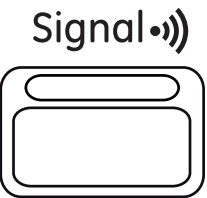 | Cycle Signal Use the Signal pad to change the volume of the end of cycle signal. Press the pad until you reach the desired volume. |
8. | 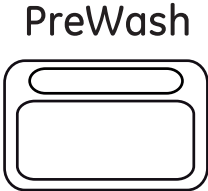 | Prewash (on some models) Prewash is an extra wash before the main wash. Use it for heavily soiled clothes or for clothes with a care label that recommends prewashing before washing. Be sure to add high-efficiency detergent, or the proper wash additive to the prewash dispenser. NOTE: When selecting prewash, it is recommended to use powder detergent in the main wash (detergent) compartment. |
9. | 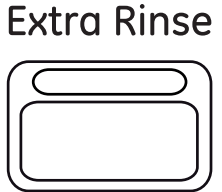 | Extra Rinse Use an extra rinse when additional rinsing is desired to remove excess dirt and detergent from soiled loads. |
10. | 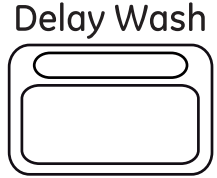 | Delay Wash (on some models) You can delay the start of a wash cycle for 10–18 hours, depending on the model. Press the Delay Wash pad to choose the number of hours you want to delay the start of the cycle, then press the Start pad. The machine will count down and start automatically at the correct time. NOTE: If you forget to fully close the door, a reminder signal will beep reminding you to do so. NOTE: If you open the door when the delay is counting down, the machine will enter the pause state. You must close the door and press Start again in order to restart the countdown. |
11. |  | Lock You can lock the controls to prevent any selections from being made. Or you can lock the controls after you have started a cycle. Children cannot accidentally start the washer by touching pads with this option selected. To lock the washer controls, press and hold the Lock pad for 3 seconds. To unlock the washer controls, press and hold the Lock pad for 3 seconds. The control lock icon on the display will light up when it is on. NOTE: The Power pad can still be used when the machine is locked. |
12. |  | My Cycle (on some models) To save a favorite cycle, set the desired settings for wash cycle, soil level, spin speed and wash temp settings and hold down the My Cycle pad for 3 seconds. A beep will sound to indicate the cycle has been saved. To use your custom cycle, press the My Cycle pad before washing a load. To change the saved cycle, set the desired settings and hold down the My Cycle pad for 3 seconds. NOTE: When using My Cycle, wash options cannot be modified after the cycle has been started. NOTE: If you change wash options with My Cycle before starting the cycle, the My Cycle light will turn off and you will be returned to the base cycle. |
13. |  | eWash (Energy Saving Wash) Use eWASH to save energy on specified wash cycles. eWASH cannot be used with Steam Refresh, Stain Wash or Basket Clean . |
14. | 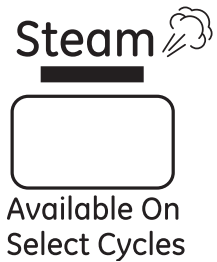 | Steam (on some models) Steam adds steam into the washer during Whites, Colors/Normals, Stain Wash, Sanitize or Bulky Bedding cycles. To use:
|
15. | 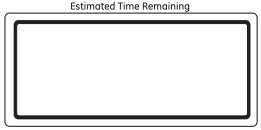 | Display The display shows the approximate time remaining until the end of the cycle. NOTE: The cycle time is affected by how long it takes the washer to fill. This depends on the water pressure in your home. |
FEATURES
The Dispenser Drawer
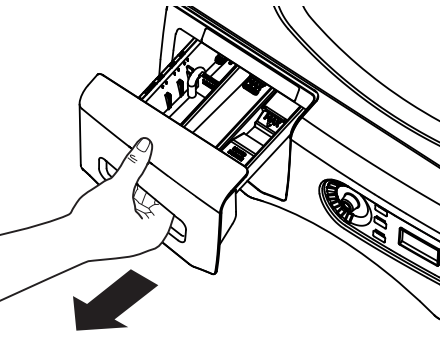 | Slowly open the dispenser drawer by pulling it out until it stops. After adding laundry products, slowly close the dispenser drawer. Closing the drawer too quickly could result in early dispensing of the bleach, fabric softener or detergent. You may see water in the bleach and fabric softener compartments at the end of the cycle. This is a result of the flushing/siphoning action and is part of the normal operation of the washer. |
The Prewash Compartment (on some models)
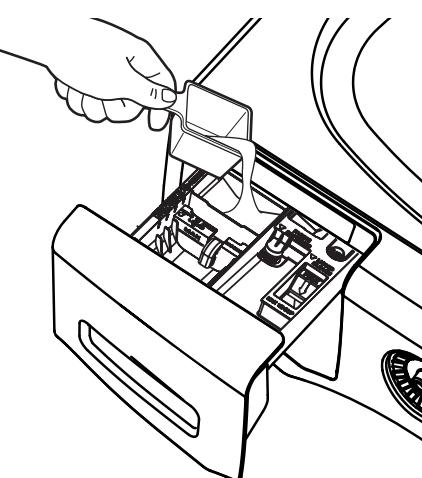 |
NOTE: Liquid detergent will drain into the washer drum as it is added.
|
The Detergent Compartment
- High-efficiency detergent is required for this washer. Use the detergent manufacturer’s recommended amount.
The detergent selection insert must be placed in the detergent compartment in a specific position according to what type of detergent you are using.
- Powder Detergent – Remove the detergent selection insert.
- Liquid Detergent – You will need to adjust the insert according to the type of Liquid
Detergent you are using. The Icons on the side of the detergent compartment must line up on the center when the insert is in position.
NOTE: Not all models have the 2x and 3x detergent settings. Some have only regular HE detergent settings. You must reduce the amount of detergent for 2x or 3x detergent per bottle instructions.
Move the insert by pulling it up and replace it by sliding it down between either the rear or front detergent compartment molded rails, as desired, for liquid detergent. Remove for powder detergent.
- Add measured detergent to the front left detergent compartment of the dispenser drawer.
- Detergent is flushed from the dispenser at the beginning of the wash cycle. Either powdered or liquid detergent can be used.
- Detergent usage may need to be adjusted for water temperature, water hardness, size and soil level of the load. Avoid using too much detergent in your washer as it can lead to oversudsing and detergent residue being left on the clothes.
- Using more detergent than the recommended quantity can cause residue buildup on your washer.
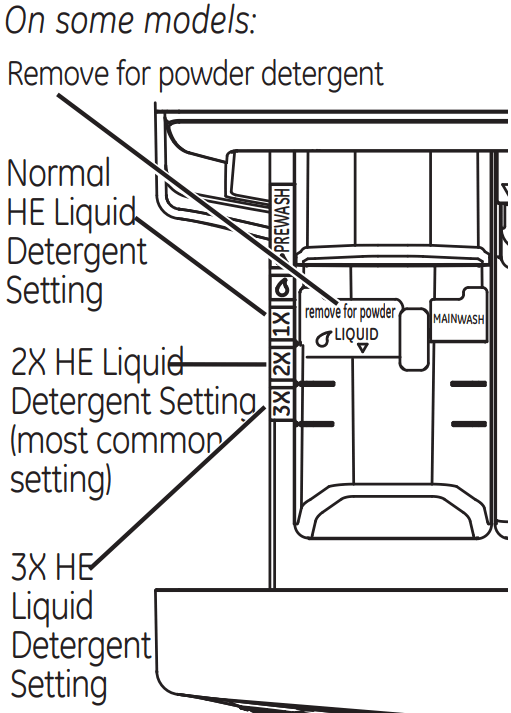 | 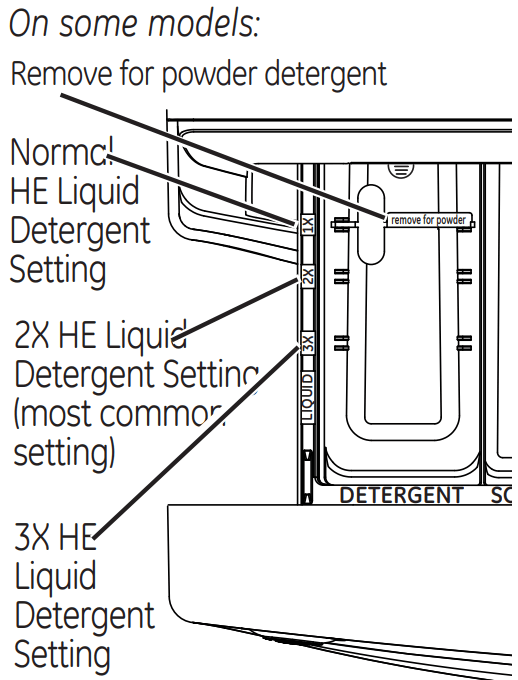 |
The Liquid Bleach Compartment
IMPORTANT: The bleach compartment position varies by model. Be sure to identify the correct compartment for bleach before using.
If desired, measure out the recommended amount of liquid bleach, not to exceed cup (80 ml), and pour into the right compartment labeled “LIQUID BLEACH”.
Do not exceed the maximum fill line. Overfilling can cause early dispensing of the bleach which could result in damaged clothes.
NOTE: Do not use powdered bleach in the dispenser.
 | 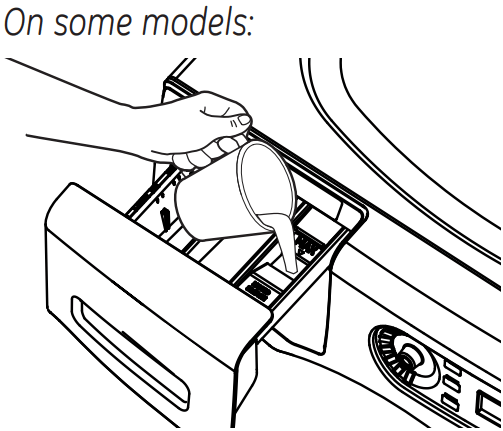 |
The Fabric Softener Compartment
IMPORTANT: The fabric softener compartment position varies by model. Be sure to identify the correct compartment for fabric softener before using.
If desired, pour the recommended amount of liquid fabric softener into the compartment labeled “FABRIC SOFTENER.”
Use only liquid fabric softener in the dispenser.
Dilute with water to the maximum fill line.
Do not exceed the maximum fill line. Overfilling can cause early dispensing of the fabric softener which could stain clothes.
NOTE: Do not pour fabric softener directly on the wash load.
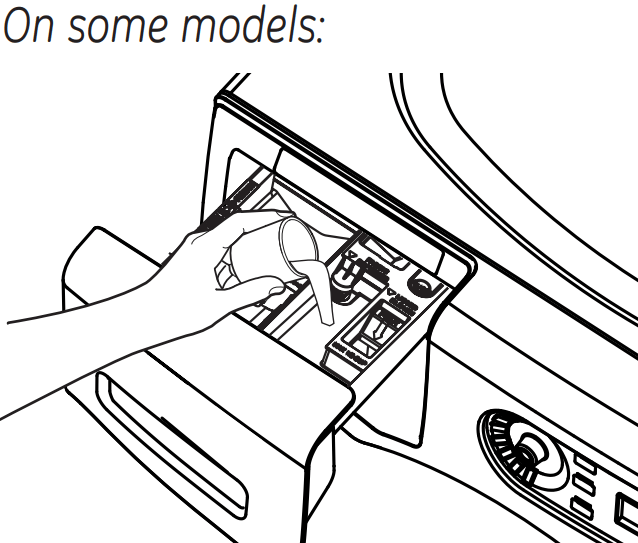 |  |
LOADING AND USING THE WASHER
Sorting Wash Loads
Sort laundry into loads that can be washed together.

- Combine large and small items in a load. Load large items first. Large items should not be more than half the total wash load.
- Washing single items is not recommended. This may cause an out-of-balance load. Add one or two similar items.
- Pillows and comforters should not be mixed with other items. This may cause an out-of-balance load
WARNING Fire Hazard
Never place items in the washer that are dampened with gasoline or other flammable liquids.
No washer can completely remove oil.
Do not dry anything that has ever had any type of oil on it (including cooking oils).
Doing so so can result in death, explosion, or fire.
Preparing Clothes
- To avoid snags during washing: Follow these steps to maximize garment care.
- Close garment zippers, snaps, buttons and hooks.
- Mend seams, hems, tears.
- Empty all items from pockets.
- Remove nonwashable garment accessories such as ornaments and nonwashable trim materials.
- To avoid tangling, tie strings, draw ties and belt-like materials.
- Brush away surface dirt and lint; treat spots and stains.
- Promptly wash wet or stained garments to maximize results.
- Mix garments using recommended maximum load sizes on page 11.
- Use nylon mesh garment bags to wash small items.
- Wash multiple garments at one time for best results.
Loading the Washer
Wash drum may be fully loaded with loosely added items. Do not wash fabrics containing flammable materials (waxes, cleaning fluids, etc.).
To add items after washer has started, press Start and wait until the door is unlatched. The washer may take up to 30 seconds to unlock the door after pressing Start depending on the machine conditions. Do not try to force open the door when it is locked. After the door unlocks, open gently. Add items, close the door and press Start to restart.
Maximum Loading Sizes*

*Exceeding maximum recommended load sizes may affect cleaning performance and garment care.
**Using a nylon mesh bag for small items is recommended.
CARE AND CLEANING
Exterior: Immediately wipe off any spills. Wipe with damp cloth. Do not hit surface with sharp objects.
Moving and Storage: Ask the service technician to remove water from drain pump and hoses.
Do not store the washer where it will be exposed to the weather. When moving the washer, the tub should be kept stationary by using the shipping bolts removed during installation.
See Installation Instructions in this book. If these parts are not available, they can be ordered by visiting our Website at GEAppliances.com or by calling 800.GE.CARES. In Canada, call 800.561.3344.
Long Vacations: Be sure the water supply is shut off at the faucets. Drain all water from the hoses if the weather will be below freezing.
Cleaning the Interior of the Washer
To clean the interior of the washer, select the Basket Clean feature on the control panel. The cycle will use more water, in addition to bleach, to refresh your washer.
NOTE: Read the instructions below completely before starting the Basket Clean cycle.
- Remove any garments or objects from the washer and ensure the washer basket is empty.
- Open the washer door and pour one cup or 250 ml of liquid bleach or other washing machine cleaner into the basket.
- Close the door and select the Basket Clean cycle. Push the Start pad.
- When the Basket Clean cycle is working, you will see CLn on the display. The cycle will complete in about 90 minutes. Do not interrupt the cycle.
- After the cycle is complete, leave the door open slightly for better ventilation.
If for any reason the cycle needs to be interrupted, the door will not open immediately. Forcing open the door at this stage may cause water to flood.
The door will open after the water is drained to a level where it would not flood the floor.
Basket Clean may be interrupted by pressing the Start pad in between cycles. A power outage in the house might also interrupt the cycle. When the power supply is back, the Basket Clean cycle resumes where it had stopped. When interrupted, be sure to run a complete
Basket Clean cycle before using the washer. If the Power pad is pressed during Basket Clean, the cycle will be lost.
IMPORTANT:
- Run Basket Clean with 1 Cup (250 ml) of bleach once a month.
- After the completion of a Basket Cleancycle, the interior of your washer may have a bleach smell.
- It is recommended to run a light color load after the Basket Clean cycle.
Cleaning the Pump Filter
Due to the nature of the front-load washer, it is sometimes possible for small articles to pass to the pump. The washer has a filter to capture lost items so they are not dumped to the drain. To retrieve lost items, clean out the pump filter.
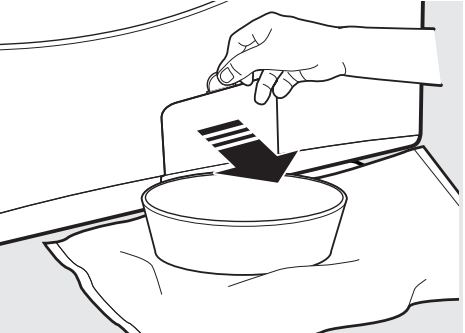 | 1. Using a coin or flat screwdriver in the notch on the door, open the access door. 2. Place a shallow pan or dish under the pump access door and towels on the floor in front of the washer to protect the floor. It is normal to catch about a cup of water when the filter is removed. |
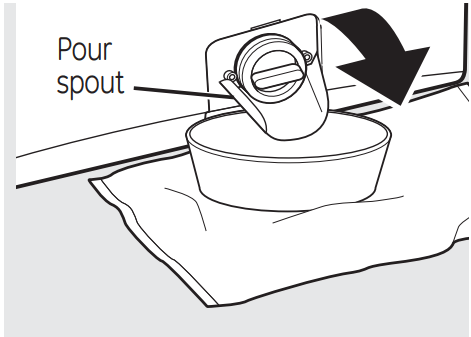 | 3. Pull down the pour spout. |
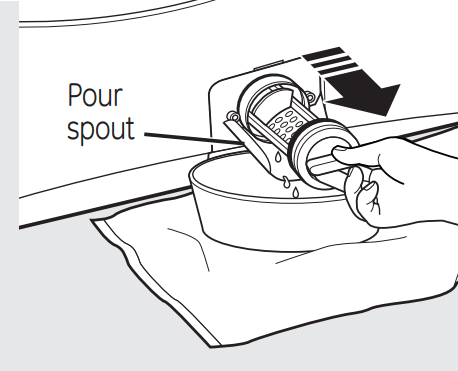 | 4. Turn the pump filter counterclockwise and remove the filter. Open slowly to allow the water to drain. 5. Clean the debris from the filter. 6. Replace the filter and turn clockwise. Tighten securely. |
 | 7. Flip up the pour spout. 8. Close the access door. |
Cleaning the Door Gasket
 | Open the washer door. Using both hands, press down the door gasket. Remove any foreign objects if found trapped inside the gasket. Make sure there is nothing blocking the holes behind the gasket. |
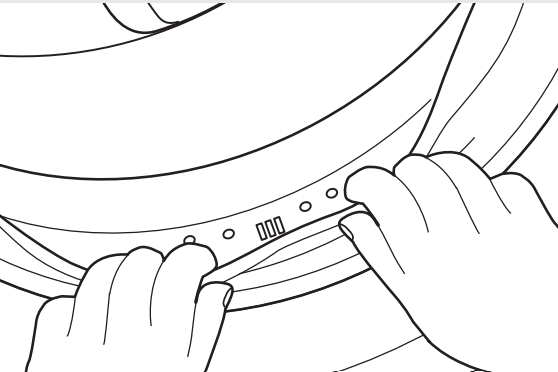 | While holding down the door gasket, inspect the interior gasket by pulling it down with your fingers. Remove any foreign objects if found trapped inside this gasket. Make sure there is nothing blocking the holes behind the gasket. |
When you are finished cleaning the door gasket, remove your hands and the gasket will return to the operating position.
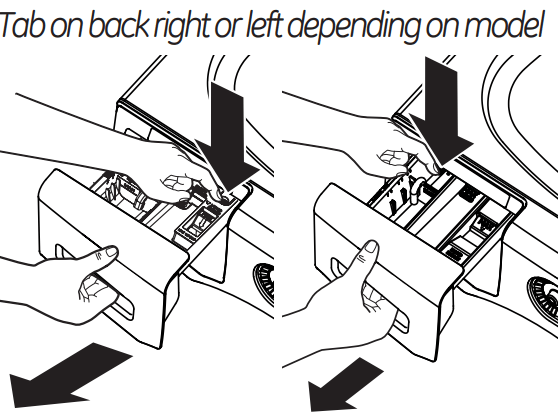 Lock tab is visible only after drawer has been pulled open | Dispenser Drawer Area: Detergent and fabric softener may build up in the dispenser drawer. Residue should be removed once or twice a month.
|
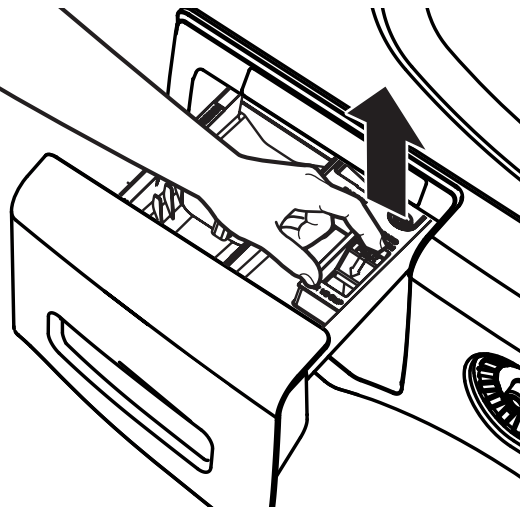 |
|
 |
|
TROUBLESHOOTING
Problem | Possible Cause | What To Do |
|---|---|---|
Not draining Not spinning Not agitating | Load is out of balance | • Redistribute clothes and run drain & spin or rinse & spin. |
| • Increase load size if washing small load containing heavy and light items. | ||
| Pump clogged | • Clean the Pump Filter. |
| Drain hose is kinked or improperly connected | • Straighten drain hose and make sure washer is not sitting on it. |
| Household drain may be clogged | • Check household plumbing. You may need to call a plumber. |
| Drain hose siphoning; drain hose pushed too far down the drain | • Ensure there is an air gap between hose and drain. |
Leaking water | Door gasket is damaged | • Check to see if gasket is seated and not torn. Objects left in pockets may cause damage to the washer (nails, screws, pens, pencils). |
| Door gasket not damaged | • Water may drip from the door when the door is opened. This is a normal operation. |
| • Carefully wipe off rubber door seal. Sometimes dirt or clothing is left in this seal and can cause a small leak. | |
| Check back left of washer for water | • If this area is wet, you have oversudsing condition. Use less detergent. |
| Fill hoses or drain hose is improperly connected | • Make sure hose connections are tight at washer and faucets and make sure end of drain hose is correctly inserted in and secured to drain facility. |
| Household drain may be clogged | • Check household plumbing. You may need to call a plumber. |
| Dispenser clogged | • Powder soap may cause clogs inside the dispenser and cause water to leak out the front of the dispenser. Remove drawer and clean both drawer and inside of dispenser box. Please refer to Cleaning the Washer section. |
| Incorrect use of detergent | • Use HE and correct amount of detergent. |
| Dispenser box crack | • If new installation, check for crack on inside of dispenser box. |
Clothes too wet | Load is out of balance | • Redistribute clothes and run drain & spin or rinse & spin. |
| • Increase load size if washing small load containing heavy and light items. | ||
| • The machine will slow the spin speed down to 410 rpm if it has a hard time balancing the load. This speed is normal. | ||
| Pump clogged | • Clean the Pump Filter. | |
| Overloading | • The dry weight of the load should be less then 16 lb. | |
| Drain hose is kinked or improperly connected | • Straighten drain hose and make sure washer is not sitting on it. | |
| Household drain may be clogged | • Check household plumbing. You may need to call a plumber. | |
| Drain hose siphoning; drain hose pushed too far down the drain | • Ensure there is an air gap between hose and drain. | |
| Incomplete cycle or timer not advancing | Automatic load redistribution | • Timer adds 3 minutes to cycle for each rebalance. 11 or 15 rebalances may be done. This is normal operation. Do nothing; the machine will finish the wash cycle. |
| Pump clogged | • Clean the Pump Filter. | |
| Drain hose is kinked or improperly connected | • Straighten drain hose and make sure washer is not sitting on it. | |
| Household drain may be clogged | • Check household plumbing. You may need to call a plumber. | |
| Drain hose siphoning; drain hose pushed too far down the drain | • Ensure there is an air gap between hose and drain. | |
| Loud or unusual noise; vibration or shaking | Cabinet moving | • Washer is designed to move 1/4" to reduce forces transmitted to the floor. This movement is normal. |
| All rubber leveling legs are not firmly touching the floor | • Push and pull on the back right and then back left of your washer to check if it is level. If the washer is uneven, adjust the rubber leveling legs so they are all firmly touching the floor and locked in place. Your installer should correct this problem. | |
| Unbalanced load | • Open door and manually redistribute load. To check machine, run rinse and spin with no load. If normal, unbalance was caused by load. | |
| Pump clogged | • Clean the Pump Filter. | |
| No power/washer not working or dead | Washer is unplugged | • Make sure cord is plugged securely into a working outlet. |
| Water supply is turned off | • Turn both hot and cold faucets fully on. | |
| Circuit breaker/fuse is tripped/blown | • Check house circuit breakers/fuses. Replace fuses or reset breaker. Washer should have separate outlet. | |
| Automatic self system checks | • First time the washer is plugged in, automatic checks occur. It may take up to 20 seconds before you can use your washer. This is normal operation. | |
| Snags, holes, tears, rips or excessive wear | Overloaded | • Do not exceed maximum recommended load sizes. See recommended maximum load size. |
| Pens, pencils, nails, screws or other objects left in pockets | • Remove loose items from pockets. | |
| Pins, snaps, hooks, sharp buttons, belt buckles, zippers and sharp objects left in pockets | • Fasten snaps, hooks, buttons and zippers. | |
| Control time wrong or changes | This is normal | • During spin the washer may need to rebalance the load sometimes to reduce vibrations. When this happens, the estimated time is increased causing time left to increase or jump. |
| Not enough water | This is normal | • Horizontal washers do not require the tub to fill with water like top-load washers. |
| Washer pauses or has to be restarted, or washer door is locked and will not open | Pump clogged | • Clean the Pump Filter. |
| Door unlocks or press Start and machine doesn’t operate | This is normal | • Front-load washers start up differently than top-load washers, and it takes 30 seconds to check the system. The door will lock and unlock. |
| Incorrect operation | • Simply open and close the door firmly; then press Start. |
Water does not enter washer or enters slowly | Automatic self system checks | • After Start is pressed, the washer does several system checks. Water will flow 60 seconds after Start is pressed. |
Water supply is turned off | • Turn on both hot and cold faucets fully. | |
Water valve screens are stopped up | • Turn off the water source and remove the water connection hoses from the upper back of the washer. Use a brush or toothpick to clean the screens in the machine. Reconnect the hoses and turn the water back on. | |
| Inlet hose screen washers are stopped up | • Turn off the water source and remove the inlet hoses from the wall faucets. Use a brush or toothpick to clean the screen washers in the end of the hoses. Reconnect the hoses and turn the water back on. | |
Wrinkling | Improper sorting | • Avoid mixing heavy items (like work clothes) with light items (like blouses). |
| Overloading | • Load your washer so clothes have enough room to move freely. | |
| Incorrect wash cycle | • Match cycle selection to the type of fabric you are washing (especially for easy care loads). | |
| Repeated washing in water that is too hot | • Wash in warm or cold water. | |
Grayed or yellowed clothes | Not enough detergent | • Use correct amount of detergent. |
| Not using HE (high-efficiency) detergent | • Use HE detergent. | |
| Hard water | • Use hottest water safe for fabric. • Use a water conditioner like Calgon brand or install a water softener. | |
| Water is not hot enough | • Make sure water heater is delivering water at 120°-140°F (48°-60°C). | |
| Detergent is not dissolving | • Try a liquid detergent. | |
| Dye transfer | • Sort clothes by color. If fabric label states wash separately, unstable dyes may be indicated. | |
| Colored spots | Incorrect use of fabric softener | • Check fabric softener package for instructions and follow softener directions for using dispenser. |
| Dye transfer | • Sort whites or lightly colored items from dark colors | |
| • Promptly remove wash load from washer. | ||
Water temperature is incorrect | Water supply is improperly connected | • Make sure hoses are connected to correct faucets. |
| House water heater is not set properly | • Make sure house water heater is delivering water at 120°-140°F (48°-60°C). | |
Slight variation in metallic color | This is normal | • Due to the metallic properties of paint used for this unique product, slight variations of color may occur due to viewing angles and lighting conditions. |
Bad odor inside your washer | Washer unused for a long time, not using recommended qualityof HE detergent or used too much detergent | • Run a Basket Clean cycle. |
| • in the case of strong odor, you may need to run the Basket Clean cycle more than once. | ||
| • Use only the amount of detergent recommended on the detergent container. | ||
| • Use only HE (high-efficiency) detergent. | ||
| • Always remove wet items from the washer promptly after machine stops running. | ||
| • Leave the door slightly open for the water to air dry. Close supervision is necessary if this appliance is used by or near children. Do not allow children to play on, with or inside this or any other appliance. | ||
| Detergent leak | Incorrect placement of detergent insert | • Make sure detergent insert is properly located and fully seated. Never put detergent above max line. |
| Improper dispensing of softener or bleach | Dispenser clogged | • Monthly clean the dispenser drawer to remove buildup of chemicals. |
| Softener or bleach is filled above the max line | • Make sure to have the correct amount of softener or bleach. | |
| Softener or bleach cap issue | • Make sure softener and bleach cap for dispenser are seated or they will not work. |
See other models: GSS22JFPJCC WJSR4160D0WW PFCF1NJXBWW AEZ06LPQ1 ESH25XGPAWW
